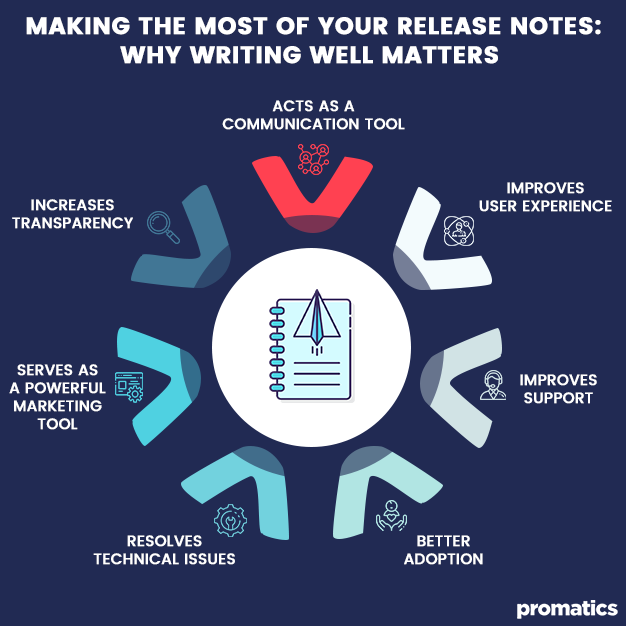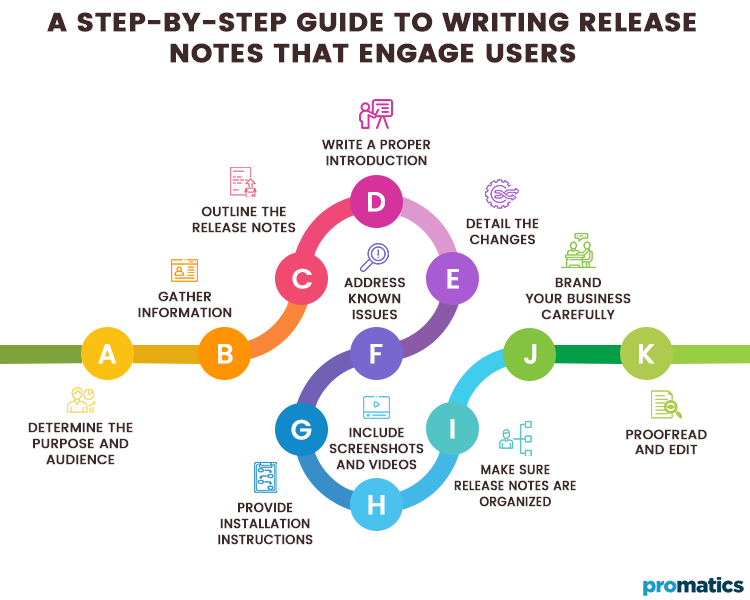From Boring to Brilliance: Tips for Writing App Release Notes
What if your product updates or features don’t find the desired audience? You aren’t utilizing one of the top communication channels, “Release notes.” Release notes are essential to every software release and serve as a communication tool between product teams and users. It should provide enough information to be informative but also easy to understand and relevant to the audience. When done well, release notes can increase user engagement, build trust, and even drive the adoption of new features. Release notes summarize the new features in a release.
Imagine your software is just a few days from release, and the product team still needs to be ready with the release note. What to do? Don’t worry. Our guide will explore the best ways to write release notes. These tips will help you write clear, informative, and valuable release notes regardless of your level of experience.
What are release notes?
A release note is a document that provides information about changes, updates, and new features of upcoming software products. It is typically created by the development team and is intended for end-users, stakeholders, and customers. The purpose of a release note is to communicate what has been added, modified, or fixed in a particular version of the software. This information can be useful for users who want to know what changes to expect in a software update and what new functionality is available to them.
Release notes may also include information about known issues and workarounds, as well as instructions for installing or upgrading to the latest version of the software. Release notes are an important part of the software development process. As a result, users are always updated about new features and can take advantage of them. A release note, also known as a changelog, is essential to the release process.
Release notes are usually written by:
a.) A product owner or product manager
b.) Developer/ development team
c.) Quality Assurance (QA) analysts
d.) Technical writer
e.) Marketing team
Why should companies provide good release notes for their products?
Communication
Release notes serve as a communication tool between the development team and the end users. They provide a clear and concise summary of the changes made in a particular release. It allows users to stay informed about what is new and what has been improved.
Transparency
Good release notes increase transparency and builds trust between the development team and the end users. Detailed information about changes in a release promotes trust in the development team and confidence in upgrade and installation decisions.
Improve user experience
Release notes explain how users can benefit from new features and functionality in software. It provides clear and comprehensive information about changes and updates. As a result, the user experience and satisfaction are improved.
Powerful marketing tool
Product release notes generate excitement and interest in the upcoming release. Customers understand how the product is constantly updating. As a result, they are excited about the product changelog. Companies can distribute release notes through different mediums (which we will explain later in the article), which will serve as marketing tools.
Resolves technical issues
A good release note includes information about known bugs and issues as well as instructions for fixing them. This helps users quickly identify and resolve technical issues, reducing the likelihood of frustration and support requests. Make a perfect link between the company and its customers.
Better adoption
Effective release notes help users understand why upgrading is a good idea. When users are aware of new features and improvements, they are more likely to adopt the new version and make the most of the software’s capabilities.
Improved support
Release notes can act as customer support service. In good release notes, changes are described clearly and concisely, making it easier for customer service teams to help users without even communicating with them. Therefore, users receive better support, and response times are reduced.
The best ways to write release notes
Release notes are a crucial part of the software development process. To accomplish this, it is essential to clearly communicate any changes and updates made in a particular release, as well as any known issues. Let’s take a look at how to write the best release notes for your new release product or updates. You can follow these steps to ensure your release notes are concise, easy to read, and provide users with the information they need. To do that:
Determine the purpose and audience
The first and most important step is to understand your audience. Before writing the release notes, it is important to determine the purpose and target audience of the document. Keep in mind which type of audience will read your release note. What are they expecting from the new updates? What were the issues with the last releases? It will help your development team or the marketing team to create an effective release note for your product.
Gather information
You have to gather all the relevant information about the changes made in the release. Information about new features, bug fixes, performance improvements, and known issues. This information can come from the development team, product managers, and QA teams.
Outline the release notes
Create an outline of the release notes, including a list of the changes made in the release, any new features, and any known issues. This will help ensure that the release notes are well-organized and easy to read. When crafting a release note for your product, follow a general template. While you can communicate with your audience in your own way, a release note provides the details:
i.) Overview of the changes
ii.) Describe the impact on users in detail
iii.) An update on any modifications made to the previous release notes
iv.) Detailed information on any new features or functionalities, as well as any enhancements made to existing ones
v.) A list of any issues that have been resolved
vi.) An acknowledgment of any ongoing challenges and limitations, along with a plan for addressing them.
Write a proper introduction
Start the release notes with a brief introduction that provides context and sets the stage for the rest of the document. You should include the version number, the release date, and a high-level summary of the changes. The reader will read your release’s introduction first, so give them a quick overview. The introduction will determine whether they continue.
Detail the changes
In the main section of the release notes, provide a detailed list of the changes made in the release. It is important to provide information about new features, fixes, performance improvements, and other changes relevant to end users. Keep in mind what possible questions may arise for the users when reading the release note. You have to answer all the questions using concise and simple language. Avoid using technical language that may confuse the reader. Use clear and simple words and phrases. Test the readability of the notes by reading them aloud to someone not familiar with the technical background. Adopt a tone consistent with your brand to connect with customers and drive loyalty.
Address known issues
If there are known issues in the release, include instructions for resolving them in the release notes. Users who encounter problems will benefit from this information, which will reduce the number of support requests.
Provide installation instructions
If there are any special instructions for installing the latest version of the software, include them in the release notes. This will help ensure that users can successfully upgrade or install the software and take advantage of the new features and improvements.
Include screenshots and videos
Your release notes are long; include a GIF or screenshot to show the change. Include screenshots or videos illustrating the changes and new features in the release. Users will be able to easily understand the changes and make the most of the software’s capabilities this way. Additionally, if your release note has a number of pages, make sure to include visuals to make everything clear. People only remember 20% of plain text, but adding visuals can help improve understanding.
Make sure release notes are organized
You must organize your release note for the users. Make the release notes easier to read by using subheads, drop-down menus, bullet points, and breaks. This way, users can quickly find the changes that affect them. You can take an example of Amazon Business release notes which are organized by category, product, and date.
Brand your business carefully
Incorporating brand messaging into your release notes is okay, but don’t overdo it with excessive self-promotion. This can damage customer trust. Instead, find a balance and use release notes to help reinforce your brand messaging. However, be cautious about how you present the information. Avoid making grandiose claims or overhyping the changes.
Proofread and edit
Before publishing the release notes, be sure to proofread and edit the document for clarity and accuracy. Check for typos, grammatical errors, and any other issues that could confuse or mislead the reader.
How to distribute the release notes?
There are several ways to distribute release notes, depending on the software and the target audience. The best approach will depend on the size of the user base, the level of technical knowledge of the users, and the communication channels available. In order to distribute release notes, companies can use the following methods:
One of the most common ways to distribute release notes is via email. Users and customers can receive a direct message from the development team with a link to the release notes.
In-app notification
Software developers can use in-app notifications to notify users about the latest releases and provide links to the release notes. The software must, however, include the feature.
Website
Release notes can be posted on the software’s website, along with other important information such as tutorials, user guides, and FAQs. This provides users with a centralized location to find information about the software and its releases.
Social media
Nowadays, social media is a great way to distribute release notes. Social media platforms such as Twitter, Facebook, and LinkedIn can also be used to distribute release notes. These platforms allow the development team to reach a wider audience and share information about the latest releases.
Release management tools
Specialized release management tools can be used to distribute release notes. In addition to automating the distribution of release notes, these tools can also be integrated with software development tools.
Final words
There is no doubt that writing effective release notes is an essential part of the software development process. Customers can use them to find out what features have been changed and fixed in the new release, and they can upgrade their systems if necessary. If you are looking for the best ways to write release notes, follow our guidelines. Combining these methods allows the development or marketing team to reach the largest number of users and keep everyone informed.
Still have your concerns?
Your concerns are legit, and we know how to deal with them. Hook us up for a discussion, no strings attached, and we will show how we can add value to your operations!



